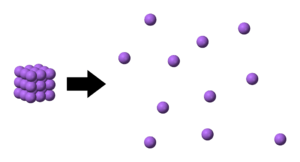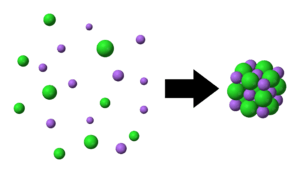A-level Chemistry/OCR (Salters)/Born-Haber cycles
< A-level Chemistry < OCR (Salters)Atomisation
Atomisation is the process of converting an element in its standard state to a monatomic gas.
The amount of energy required to achieve atomisation is termed the enthalpy change of atomisation, ΔHat, measured in kJ mol−1.
The quantity you find in most data tables is the standard enthalpy change of atomisation, which is the amount of energy required to convert one mole of an element in its standard state to a monatomic gas, under standard conditions.
The equation for atomisation is:
- where σ represents the standard state of the element, so
- if E is a solid is its standard state, σ = s
- if E is a liquid is its standard state, σ = l
- if E is a gas is its standard state, σ = g.
For example, the symbol  represents the standard enthalpy change of atomisation of sodium,
represents the standard enthalpy change of atomisation of sodium, 

The case of chlorine is slightly more complicated:  represents the standard enthalpy change of atomisation of chlorine,
represents the standard enthalpy change of atomisation of chlorine, 

Ionisation

Electron affinity

Lattice enthalpy

This article is issued from Wikibooks. The text is licensed under Creative Commons - Attribution - Sharealike. Additional terms may apply for the media files.
